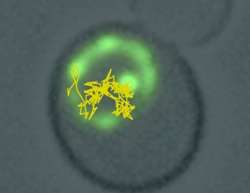On the move for repair

Scientists from the Friedrich Miescher Institute for Biomedical Research have elucidated mechanisms that control DNA movement in the nucleus. They found that DNA with double-strand breaks moves more than undamaged DNA, thereby ensuring that breaks are properly repaired. Error-free double-strand break repair requires that the severed DNA finds a homologous sequence, which can serve as its repair template. Enhanced movement in the nucleus appears to facilitate the search for a proper template. Given that improperly repaired double-strand breaks can cause deleterious translocations that lead to cancer, this mechanism is important for maintaining cell integrity.
The nucleus is highly organized and several specialized sub-compartments have been described in the context of transcription. For example, in budding yeast, nuclear pores are highly conductive to transcription, whereas other regions of the nuclear periphery facilitate gene repression. However, mechanisms that transport chromatin to these sub-nuclear control regions have been unclear.
Using quantitative fluorescence microscopy of single genetic loci in live budding yeast, Susan Gasser and her team at the Friedrich Miescher Institute for Biomedical Research addressed the mechanistic requirements for chromatin movement. Two sets of findings were published recently in Genes & Development and Nature Cell Biology. In the first study, which focused on chromatin movement in general, they found that DNA movement could occur independently of transcription elongation, although it was driven by the large ATPases that remodel chromatin during transcriptional activation.
"The localized binding of a chromatin remodeling ATPase namely INO80 on a particular genetic locus, increased the nuclear volume that the tagged locus could explore, in a manner entirely dependent on the ATPase activity of the complex," comments Gasser.
Furthermore, they found that increased chromatin movement promoted the repair of double strand breaks by homologous recombination between distant sequences. This led to the notion that double-strand breaks might specifically make use of movement within the nucleus to facilitate the homology search for repair by homologous recombination. They tested this hypothesis in their second study.
In this second study, Vincent Dion, a postdoctoral fellow in the Gasser laboratory, scored the mobility of a site-specific double-strand break. The locus clearly moved faster and was less constrained than the same undamaged locus, exploring nearly half of the nuclear volume within minutes. Dion then identified the proteins required for the increase in movement, which included proteins necessary for chromatin remodeling (a subunit of INO80), proteins critical for homologous recombination (Rad51 and Rad54) and mediators of a damage response (Mec1 and Rad9).
"These results suggest that chromatin movement promotes a rate-limiting step in homologous recombination, namely, that of homology search," comments Dion, "On the other hand, too much movement can lead to gratuitous recombination with ectopic sequences, and can generate deleterious translocations that can lead to cancer. We have also found that there are mechanisms that keep chromatin movement in check unless a genome-wide search needs to take place."
More information: Dion V, et al. (2012) Increased mobility of double-strand breaks requires Mec1, Rad9 and the homologous recombination machinery. Nat Cell Biol. 2012 Apr 8. doi: 10.1038/ncb2465.
Neumann FR, et al. (2012) Targeted INO80 enhances subnuclear chromatin movement and ectopic homologous recombination. Genes Dev. 2012 Feb 15;26(4):369-83. doi: 10.1101/gad.176156.111
Provided by Friedrich Miescher Institute for Biomedical Research















